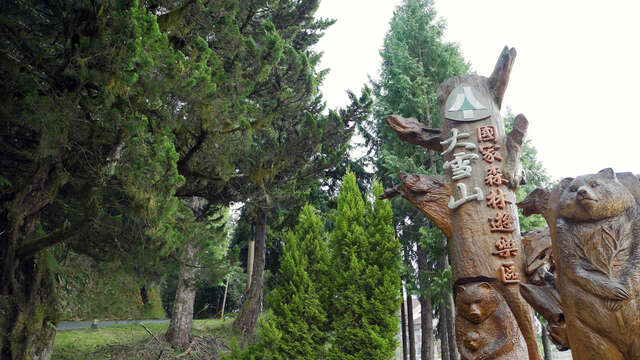Dasyueshan National Forest Recreation Area Introduction
Due to the early progress of accommodation and dining services at the Daxue Mountain National Forest Recreation Area, a brand new lunch feast will be provided starting June 4. From July 21, the first batch of 20 cabins will resume accommodation services, and the remaining accommodation spaces will be gradually opened from August to October after renovations are completed. For more information, please visit the Forestry and Nature Conservation Administration's "Taiwan Mountain Forest Travel Network" or the Taichung branch of the Forestry and Nature Conservation Administration's website, or you can contact the Daxue Mountain Visitor Center at (04) 2587-7901. Taiwan has the largest area of alpine giant cedar forests in the world, and the Daxue Mountain Forest Recreation Area, located in the southwestern part of the Snow Mountain Range, boasts the most complete alpine giant cedar forest ecosystem, which includes subalpine fir forests, cypress forests, and warm temperate broadleaf forests dominated by Fagaceae plants. Each ecological zone retains representative giant trees, making it the most delicately varied recreational area under the administration of the Forest Bureau. The terrain varies greatly, with altitudes ranging from the highest point of Xiaoxue Mountain (2,997 meters) extending southwest to Anma Mountain, Boat-shaped Mountain, and Shaolai Mountain, which drop to about 1,000 meters along the Shaolai Creek gorge. The Xiaoxue Trail segment, with altitudes between 2,200 and 2,600 meters, features both subalpine fir and warm temperate broadleaf forest characteristics. The upper section of the trail is covered with subalpine fir forests, where the undergrowth is mainly composed of the well-developed underground stem of Yushan arrow bamboo, which grows in patches resembling a grassland. Occasionally, a few cypress and dead trees can be seen, hinting at the area's past encounters with catastrophic forest fires. Amidst the mist, the towering subalpine fir giants present a breathtaking landscape akin to an ink wash painting. The forest near the lower section of the trail, close to the Boat-shaped Mountain Workstation and bordering the subalpine fir forest, is primarily composed of Fagaceae plants such as the Quercus shenii and Quercus aliena. Here, Fagaceae are distributed at higher altitudes, within the range of 1,800 to 2,500 meters in the warm temperate broadleaf forest zone, where one can envision the magnificent broadleaf forest of the past from the giant Quercus shenii and the Carpinus fabaceae in front of the Daxue Mountain Lodge. These Fagaceae serve as a major food source for many wildlife species, such as squirrels and sugar gliders, and are also habitat for various wild birds. The area from Anma Mountain Workstation to the nursery is the best place to admire the sunset at Daxue Mountain, where the splendid and colorful sunset accompanies the cloud and misty mountain scenery, creating a picturesque view that is refreshing. Entering the surrounding forest bathing trail, the cypress and scattered red cedars remain the most eye-catching in this cedar forest. In addition, species like the Taiwan cypress, Michelia floribunda, alpine ginger, Wushe ginger, Quercus shenii, and the tree rhododendron found only in eastern Himalayan and Taiwan regions flourish densely in the second layer of the cedar forest, forming a mixed coniferous and broadleaf forest with the cedars. After October, as autumn arrives, the small membranous ferns on the cedars also don their autumn attire, dressing in red and yellow to welcome this season of "autumn in the heart," showcasing a hazy misty forest view. The ferns in the undergrowth not only dominate in numbers but also reveal several species thriving in their favorite humid environment. On the way to the observation deck, looking towards the ridge of Anma Mountain on the other side of the Daxue Mountain Forest Road, straight and gray-white spruces stand majestically at a high position on the hillside, mingled with dark green and robust subalpine firs, while the slopes are adorned with cypress, two-leaf pines, and Huashan pines, supplemented by bamboo grasslands beneath, creating a vivid contrast in color that makes one reluctant to leave! Upon reaching the observation deck, the 360° panoramic view is the best spot to observe the west ridge of the Central Snow Mountain Range. Looking north, you can see Xiaoxue Mountain, to the east are Jiayang Mountain and Jian Mountain, the peaks behind are part of the Hehuan Mountain Range, and to the south, you can spot Baigou Mountain and Baxian Mountain, with Dajia River flowing below and the Central Cross-Island Highway winding through. On a clear day towards the southwest, you may even see Yushan, and to the northwest, Shaolai Mountain, Yanzui Mountain, and Boat-shaped Mountain are visible. While admiring the distant mountains, don't forget the little golden-winged white-browed sparrow hopping near your feet, giving you the chance to watch this lovely bird up close, creating unforgettable memories! Additionally, it’s recommended to visit the observation deck in the morning, as it tends to become a misty world in the afternoon. At this time, if you stroll along the Daxue Mountain Forest Road, "be careful, the imperial pheasant might be right beside you!" Beautiful encounters in the forest often arise unexpectedly; just pay attention, and the feast of nature is everywhere! Continuing from Xiaoxue Mountain lodge towards Tianchi, this area of Huashan pines on both sides of the path offers a rare opportunity to enjoy pine forests with a leisurely walk. Generally, pine tree seeds are winged for wind dispersal. However, the seeds of the Taiwan Huashan pine, known as "Taiwan's fruit pine," lack this pair of wings and rely on their large seeds to attract animals such as Formosan black crows and Formosan macaques for feeding. Through the animals’ actions, these seeds are often carried or dropped in further locations, allowing them to take root. While this method may sacrifice many seeds digested by animals, it often leads to successful germination in more distant locations due to the animals' mobility! Arriving at the Shuangxue Pavilion at Tianchi for a rest, this pavilion was completed in December of 1967. Inside, there is a couplet written by Mr. Lin Wei-fang, the first director of the Forest Research Institute: "The auspicious colors rise from the green hills, the sky is clear with feelings on all sides; the majestic snow mountain, crystal trees, flower fragrance and bird songs with myriad difficulties to ascend." The words depict the view from Tianchi overlooking Xiaoxue Mountain, adding historical depth to this forest. The millennial sacred tree stands here, marking the environment. Data indicates that this red cypress is approximately 1,400 years old, about 50 meters tall, with a diameter of 4 meters and a circumference of 13 meters, once ranking as the 11th largest giant tree in Taiwan. A passage from "Zhuangzi - Wandering in the Void" comes to mind: "Now you have a large tree, worried about its uselessness, why not plant it in a land of nothingness, wandering aimlessly beside it, freely resting underneath it, unharmed by axe and saw, for nothing that is useful can harm its essence; whence comes the suffering?" The reason this sacred tree has survived to this day could be inferred from its appearance, suggesting that it possibly evaded being cut down due to its bifurcated trunk and less-than-ideal shape.
































